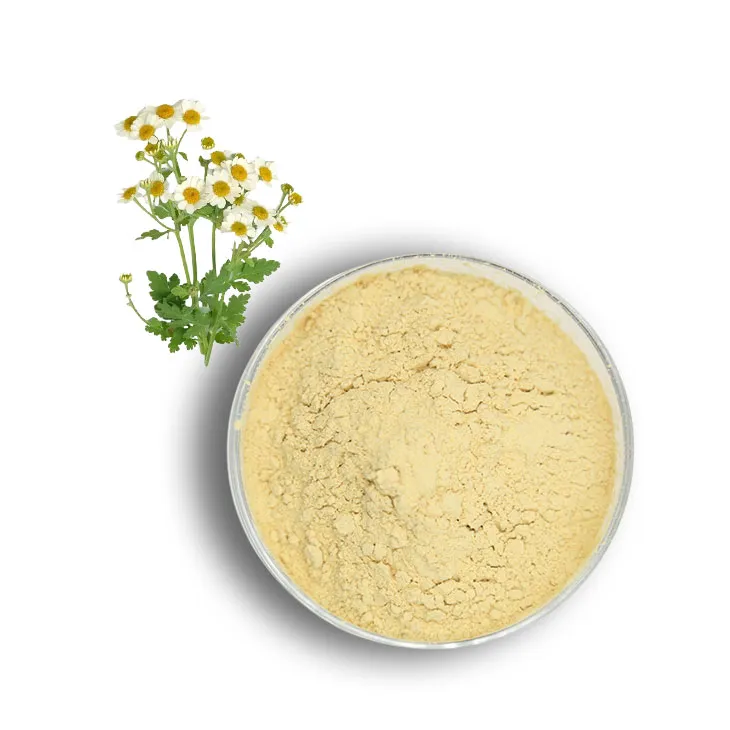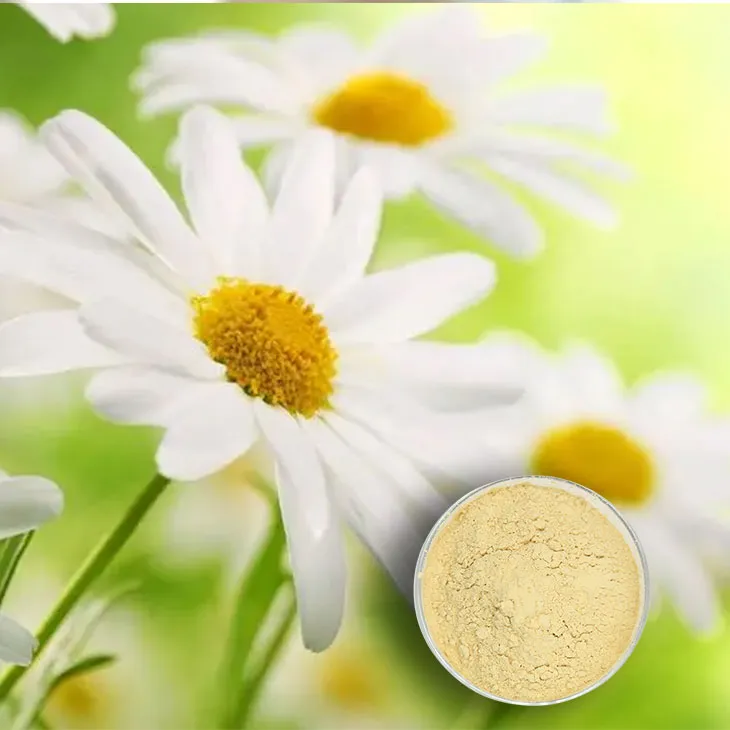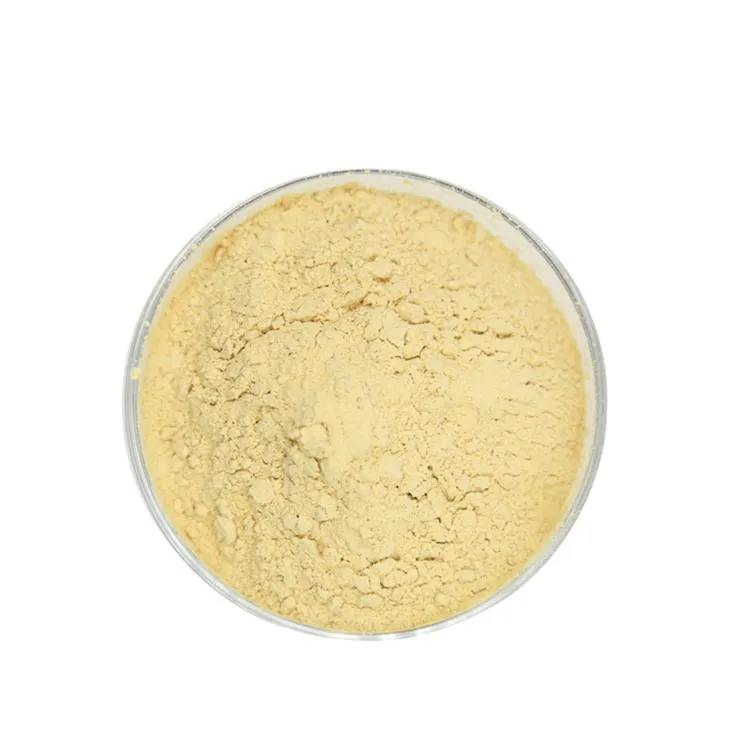- 0086-571-85302990
- sales@greenskybio.com
Extraction Technology and Production Process of Feverfew Extract
2024-11-28

1. Introduction
Feverfew (Tanacetum parthenium) is a plant known for its potential medicinal properties. The extraction of its active components to produce Feverfew Extract is of great significance in various industries, especially in the pharmaceutical and cosmetics industries. The proper extraction technology and production process are crucial to ensure the quality, safety, and effectiveness of the final extract.

2. Extraction Technologies
2.1 Steam Distillation
Steam distillation is one of the traditional and widely - used extraction methods for feverfew. This method is mainly applicable to the extraction of essential oils and some volatile active substances from feverfew.
- The principle behind steam distillation lies in the fact that the vapor pressure of the volatile components in feverfew is increased by passing steam through the plant material. As a result, these components vaporize along with the steam.
- The mixture of steam and volatile substances is then condensed, and the resulting liquid is separated into two phases: an aqueous phase and an oil phase. The oil phase contains the essential oils and other volatile active substances extracted from feverfew.
- One of the advantages of steam distillation is that it is a relatively simple and cost - effective method. It does not require complex equipment and can be carried out on a relatively large scale.
- However, it also has some limitations. For example, some heat - sensitive components in feverfew may be degraded during the steam distillation process due to the high temperature involved. Also, the extraction efficiency for certain non - volatile active substances may be low.
2.2 Microwave - Assisted Extraction
Microwave - assisted extraction is an emerging technology in the field of plant extraction, including that of feverfew.
- This method utilizes microwave energy to accelerate the extraction process. Microwaves cause the molecules in feverfew to vibrate rapidly, increasing the molecular movement of substances within the plant material.
- By enhancing molecular movement, the active components in feverfew can be more easily transferred from the plant matrix to the extraction solvent. This results in a shorter extraction time compared to traditional extraction methods.
- Some of the benefits of microwave - assisted extraction include higher extraction efficiency, which means that a larger amount of active components can be extracted in a shorter time. Additionally, it can potentially reduce the use of solvents, making the process more environmentally friendly.
- Nevertheless, microwave - assisted extraction also requires specialized equipment, which may increase the initial investment cost. There is also a need to carefully control the microwave power and extraction time to avoid over - extraction or degradation of the active components.

3. Production Process
3.1 Raw Material Quality Inspection
Quality inspection of raw materials is the first and crucial step in the production process of Feverfew Extract.
- The source of feverfew should be verified to ensure that it is from a reliable and uncontaminated origin. This may involve checking the cultivation area, whether it is free from pesticides and heavy metals contamination.
- The morphological characteristics of feverfew, such as the appearance of the plant, the color and texture of the leaves, should be examined. Any abnormal appearance may indicate poor quality or potential contamination.
- Chemical analysis of the raw feverfew is also necessary. This includes determining the content of key active components, such as parthenolide, which is one of the important bioactive substances in feverfew. If the content of active components is too low, it may affect the effectiveness of the final extract.
3.2 Extraction
Once the raw materials pass the quality inspection, the extraction process can be carried out using the selected extraction method, either steam distillation or microwave - assisted extraction.
- In the case of steam distillation, the feverfew plant material is placed in a distillation apparatus, and steam is passed through it at an appropriate temperature and pressure. The process is carefully monitored to ensure the proper vaporization and condensation of the volatile components.
- For microwave - assisted extraction, the feverfew and the extraction solvent are placed in a microwave - compatible vessel. The microwave power and extraction time are set according to the optimized parameters. The extraction solvent is chosen based on its ability to dissolve the desired active components from feverfew.
3.3 Chromatographic Separation
After extraction, the resulting extract often contains a mixture of various components. Chromatographic separation is then carried out to purify and isolate the specific active components.
- There are different types of chromatography that can be used, such as high - performance liquid chromatography (HPLC) or gas chromatography (GC), depending on the nature of the components to be separated. For example, HPLC is more suitable for separating non - volatile and polar components, while GC is mainly used for volatile components.
- The principle of chromatographic separation is based on the differential interaction of the components in the extract with the stationary phase and the mobile phase in the chromatography system. Components that have stronger interaction with the stationary phase will be retained longer, while those with weaker interaction will elute faster.
- Through chromatographic separation, the purity of the desired active components in the Feverfew Extract can be significantly increased, which is important for its further applications in the pharmaceutical and cosmetics industries.

4. Applications of Feverfew Extract
4.1 Pharmaceutical Industry
In the pharmaceutical industry, feverfew extract has shown potential in the development of natural remedies.
- Feverfew has a long history of being used for its anti - inflammatory properties. The active components in the extract, such as parthenolide, may inhibit the production of inflammatory mediators in the body. This makes it a potential candidate for the treatment of inflammatory diseases, such as arthritis.
- Some studies have also suggested that feverfew extract may have anti - migraine effects. It is believed that it can interfere with the release of certain chemicals in the brain that are associated with migraine attacks.
- The natural origin of feverfew extract makes it an attractive option for those who prefer natural or complementary medicine. It can be formulated into various dosage forms, such as tablets, capsules, or tinctures, for different administration routes.
4.2 Cosmetics Industry
In the cosmetics industry, feverfew extract is increasingly being used in formulating skin - care products.
- Due to its anti - inflammatory properties, it can be used to soothe irritated skin. It may be beneficial for people with sensitive skin or skin conditions such as eczema or rosacea.
- Feverfew extract also contains antioxidants, which can help to protect the skin from free - radical damage. Free radicals are known to cause premature aging of the skin, such as the formation of wrinkles and loss of elasticity.
- It can be incorporated into various skin - care products, such as creams, lotions, and serums. The addition of feverfew extract can enhance the functionality of these products, making them more attractive to consumers who are interested in natural and effective skin - care ingredients.

5. Conclusion
The extraction technology and production process of feverfew extract play a vital role in obtaining a high - quality product with diverse applications. Steam distillation and microwave - assisted extraction are two important extraction methods, each with its own advantages and limitations. The production process, including raw material quality inspection, extraction, and chromatographic separation, is a comprehensive system to ensure the safety and effectiveness of the final extract. The wide applications of feverfew extract in the pharmaceutical and cosmetics industries further highlight the importance of proper extraction and production techniques. Continued research and development in this area are expected to improve the extraction efficiency, quality control, and expand the applications of feverfew extract in the future.

FAQ:
What are the common extraction methods for feverfew extract?
Steam distillation is a common extraction method, which can be used to extract essential oils and some volatile active substances from feverfew. Microwave - assisted extraction is also an emerging technology. It uses microwave energy to accelerate the extraction process by increasing the molecular movement of substances in feverfew.
Why is quality inspection of raw materials important in the production process of feverfew extract?
Quality inspection of raw materials is the first step to ensure the safety and effectiveness of the final product. It helps to eliminate poor - quality raw materials, which may contain contaminants or have insufficient active components, thus ensuring the quality of the feverfew extract.
What is the purpose of chromatographic separation in the production of feverfew extract?
After extraction, chromatographic separation is often carried out to purify and isolate the specific active components. This helps to obtain a more pure and effective feverfew extract, which is beneficial for its applications in various fields.
What are the applications of feverfew extract?
Feverfew extract has wide applications. In the pharmaceutical industry, it can be used in the development of natural remedies. In the cosmetics industry, it can be used in formulating skin - care products.
How does microwave - assisted extraction work for feverfew?
Microwave - assisted extraction uses microwave energy. This energy increases the molecular movement of substances in feverfew, which in turn accelerates the extraction process, allowing for more efficient extraction of active components.
Related literature
- Advances in Extraction Technologies for Medicinal Plants: The Case of Feverfew"
- "Production Processes and Quality Control of Feverfew - Based Extracts in the Cosmetics Industry"
- "Feverfew Extract: From Extraction to Therapeutic Applications"
- ▶ Hesperidin
- ▶ citrus bioflavonoids
- ▶ plant extract
- ▶ lycopene
- ▶ Diosmin
- ▶ Grape seed extract
- ▶ Sea buckthorn Juice Powder
- ▶ Beetroot powder
- ▶ Hops Extract
- ▶ Artichoke Extract
- ▶ Reishi mushroom extract
- ▶ Astaxanthin
- ▶ Green Tea Extract
- ▶ Curcumin Extract
- ▶ Horse Chestnut Extract
- ▶ Other Problems
- ▶ Boswellia Serrata Extract
- ▶ Resveratrol Extract
- ▶ Marigold Extract
- ▶ Grape Leaf Extract
- ▶ blog3
- ▶ blog4
-
How to make powder with bayberry extract?
2024-11-28
-
The best peony root extract in nature.
2024-11-28
-
100% Pure Organic Baicalin.
2024-11-28
-
Organic Cordyceps Extract Powder Suppliers.
2024-11-28
-
Black Rice Extract
2024-11-28
-
Withania Somnifera Extract
2024-11-28
-
Black Pepper Extract
2024-11-28
-
Moringa powder
2024-11-28
-
Motherwort Extract
2024-11-28
-
Berberis aristata Extract
2024-11-28
-
Nettle leaf extract
2024-11-28
-
Lily extract
2024-11-28
-
Garcinia Cambogia Extract
2024-11-28
-
Sea buckthorn oil
2024-11-28





















